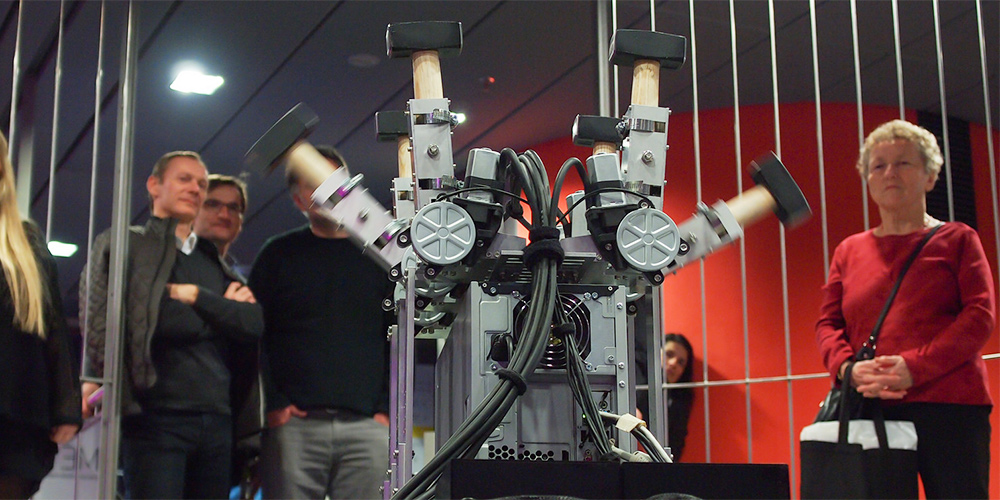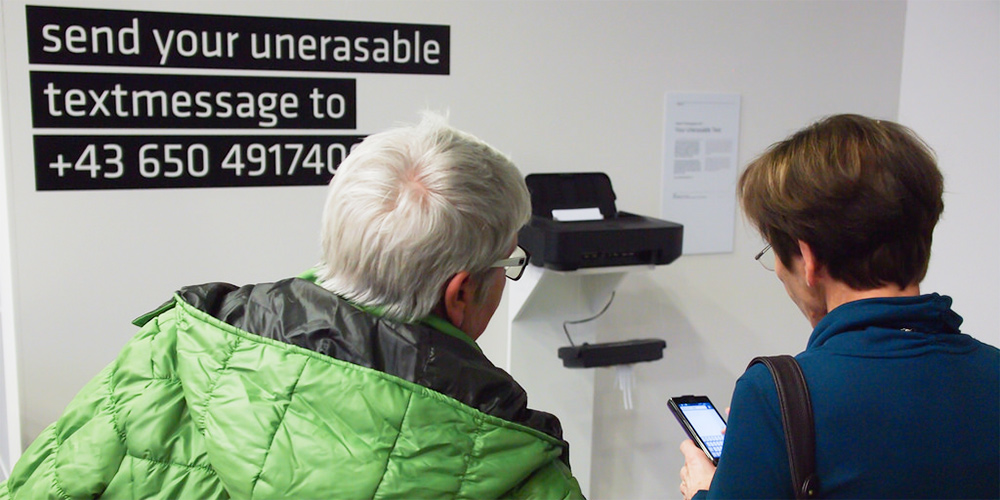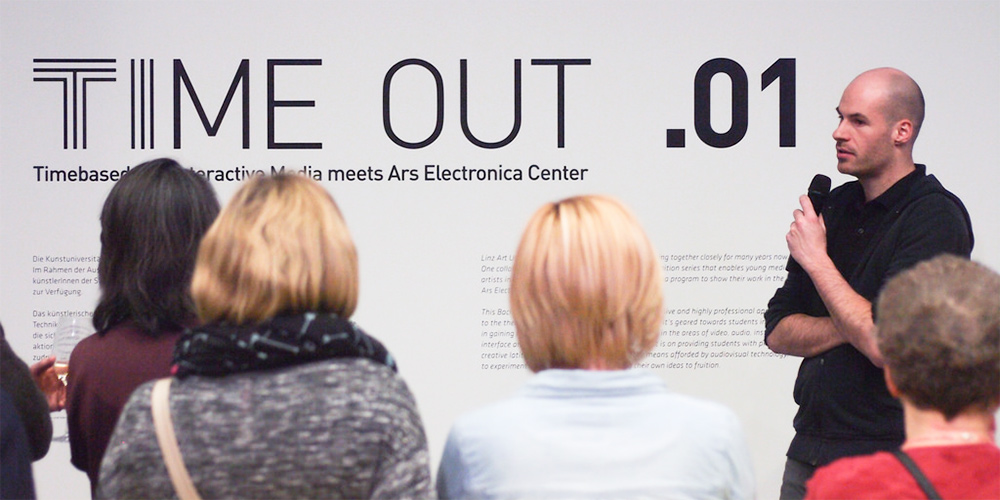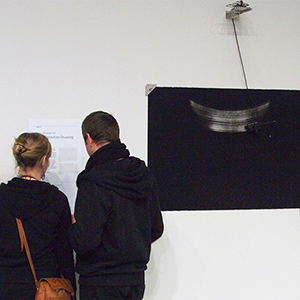
In the new exhibition series “TIME OUT .01“, which opened in January 2014 in collaboration with the program “Time-based and Interactive Media” of Linz Art University, the Austrian artist Stefan Tiefengraber presents three of his works in the foyer of the Ars Electronica Center in Linz . In this interview, the 32-year-old talks about them in more detail.
A server that destructs itself by pushing a button, a shredder that destroys SMS text messages, and a drafting machine that intentionally distorts data. The irretrievable deletion of digital data seems to be one of the commonalities of your works …
This is an impression someone will have in the beginning – the deletion, destruction and demolition. But it ‘s also important for me to show that it can be fun on the one hand, to destroy something, and on the other hand to get to know that there is something behind it. In “User Generated Server Destruction” you have the opportunity to beat a web server which you usually can never destroy in normal life. They are always locked away, there are many copies of them and you as a user never have real access to these servers. However, my work will also show what technology is able to withstand. In “Your Unerasable Text” the text message is visually destroyed, but saved in the background digitally. The message itself remains indestructible, because it could be stored by the mobile phone provider before. How far can you go to destroy technology? And what can you get out of the devices and how can you use them otherwise ? The user shall have joy to use the exhibits, and they should also begin to ask themselves what is behind technology.
What’s the attraction to destroy a server by hand for yourself?
“User Generated Server Destruction” gives users the ability to destroy a server connected to the Internet, if they want, and to make the global network smaller for a short time. An incentive was for me to set up the installation at a place where it should always be very quiet – as in museums. The visitor himself becomes the producer of noise: A simple click is usually very quiet, but here large hammers fall onto the server. It may be easier to click online than standing directly in front of the server. First, the visitors are a bit scared because they are not prepared. The installation should also make aware that the content of Facebook or Google has to be saved on such servers and that the cloud on the Internet has to be physically present somewhere. There are cables, where everything has to be plugged in, and you have to connect to computers and hard drives. All this kind needs electricity and hardware – even if you are not aware of it, it has to really exist in this world. But, like other physical things, you can also destroy webserver physically. The installation brings users and web servers together very closely.
How long does it take until a server will be destroyed with these hammers?
This is very different, you will never know exactly. The first server was no longer functional after three hits. Recently, a server has endured 250 hits and there were servers that worked two days and could never be destroyed. I like it that you will never know how long a server survies. The exhibit consists of a web server that actually runs the hosted website http://www.ugsd.net/. Once it is broken, the website is no longer accessible anymore.

What makes the text of “Unerasable text” undeletable?
“Unerasable text” gives you a visual indication that a digital message can be destroyed but it will continue to be stored in the background digitally. What is actually happening with your message, you will never know or see. It is not obvious that an SMS message from a mobile phone is also stored in a different location than on my phone storage. There is no visual evidence of the destruction, the data is still present digitally. The exhibit stores the phone number, time and the message itself. The focus here is also the fun of destruction, but the user also has the possibility to think about the topic, if he wants to.
The analogous print is only one copy of the message you have sent. You will never know exactly who has access to your data in the background. The work was created in the year 2011/12, as the data preservation in Austria was implemented – that’s why I cared about these issues. You will see very clearly how the handling of digital data changes with this example: For a long time it was not accepted by the authorities or companies to scan invoices and send them via email – today the majority accept the receiver’s signature on a digital image as an attatchement to an e-mail. That has changed with time.
Normally no one prints any SMS text message. You send something and you then can see how it will be destroyed again – a moment that will cause you to think about this topic. I also want to show that this ancient technology of SMS is pretty long and still used today, and anyone can use it with a simple mobile phone – wheter a smart phone nor user names and passwords are needed. You will only have to have a valid phone number.
My works are no indoctrinations, they are thought-provoking. Someone should start to think about the own use of technology. Why do I send a text message? How does it work, that it can be printed?

What exactly happens with the drawing machine?
It is a white paper, which I have rubbed with black pastel, and I have then fixed onto the wall. The machine grinds the black color again. This therefore generates a data visualization as a Reverse Drawing. The data it uses will be destroyed by the visualization process again because the machine works inaccurate on purpose. You can see the result yet, but if you will draw the same data again, it will not be an exact copy. How the data will look like is up to the machine. The pendulum can move in two directions: The progression of time from top to bottom, and the amount of the value to the left and right. I have already experimented with different kind of data to produce abstract images: First, I have used RGB data from images of surveillance cameras. What surveillance cameras depict is never objective but always distorted – it depends on their position, they only show excerpts, and there are far too many influences to get “objective” data.
Then I have used the data of air quality from Beijing, Shanghai and Guangzhou, which was measured by the U.S. embassies in the respective cities and was published by them on Twitter, although this was not permitted under international law. Furthermore, I have worked with random data where the program decides itself how long it draws. With “TIME OUT .01” at the Ars Electronica Center I fed the machine with data of electromagnetic radiation at various locations in Linz – including data directly from the Ars Electronica Center. A ten-minute recording of these waves will be drawn, which are presented visually by the drawing machine and can be listened to additionally. If the machine draws during the opening times of the museum, it takes several days per picture. A long process to distort the data and to make it inaccurate, although the data behind is still very short. Also, the machine is struggling to paint a picture over a long period of time. And even the inking takes about half an hour. Everything takes time.

How did you come to media art?
Before my time as a media artist, I have worked for six years at a media production company. But after some time I realized that I have to go into a different direction and so I discovered the Art University Linz. There I was finally able to concentrate on my own work. It’s a good feeling to have the freedom and opportunity to implement my own work and show them to other people. At the Art University I worked since 2010 not only with video works, but also with interactive installations – sometimes even without electricity.
In Linz, I used that time the opportunity to exhibit my work in the show window of the private television company DorfTV. So I’ve also started to present my work to the public. In 2012, I was in South Korea during my exchange year – here I had the opportunity to show an exhibition at Gallery 175. Even at the Pikselfestival’13 in Norway and the B-side Festival in Mannheim I was able to show my works. So I’m trying to take every opportunity to present my works.
The works of Stefan Tiefengraber can be seen during „TIME OUT .01“ until mid of April 2014 at the Ars Electronica Center. On SAT February 8 and SUN February 9, 2014, 2 PM, the media artist himself will talk about his works. You will find more about the exhibition series on ars.electronica.art. All works of Stefan Tiefengraber are documented on www.stefantiefengraber.com.
